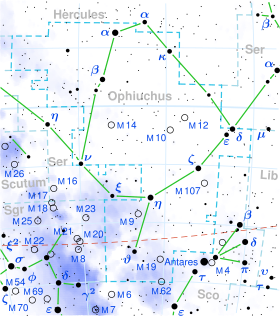| Observation data Epoch J2000 Equinox J2000 | |
|---|---|
| Constellation | Ophiuchus [1] |
| Right ascension | 16h 41m 34.38407s [2] |
| Declination | −17° 44′ 31.8047″ [2] |
| Apparent magnitude (V) | 4.91 [1] |
| Characteristics | |
| Spectral type | G7.5IICN1Ba0.4 [3] |
| U−B color index | +0.85 [4] |
| B−V color index | +1.11 [4] |
| Astrometry | |
| Radial velocity (Rv) | −25.20 [5] km/s |
| Proper motion (μ) | RA: −21.670 [2] mas/yr Dec.: −1.224 [2] mas/yr |
| Parallax (π) | 8.2914±0.2626 mas [2] |
| Distance | 390 ± 10 ly (121 ± 4 pc) |
| Absolute magnitude (MV) | −0.60 [1] |
| Details [6] | |
| Mass | 2.51 M☉ |
| Radius | 22 R☉ |
| Luminosity | 208 L☉ |
| Surface gravity (log g) | 2.15 cgs |
| Temperature | 4,667 K |
| Metallicity [Fe/H] | −0.13 [7] dex |
| Rotational velocity (v sin i) | 5.3 [8] km/s |
| Age | 692 Myr |
| Other designations | |
| 24 Sco, BD−17°4618, FK5 624, GC 22449, GJ 9574, HD 150416, HIP 81724, HR 6196, SAO 160046 [9] | |
| Database references | |
| SIMBAD | data |
24 Scorpii is a star that was originally placed by John Flamsteed within the constellation of Scorpius but in now placed within the southeastern constellation of Ophiuchus. It is visible to the naked eye as a faint, yellow-hued point of light with an apparent visual magnitude of 4.91. [1] Based on the trigonometric parallax published in Gaia Data Release 2, the star lies approximately 121 parsecs or 390 light years away. [2] It is positioned near the ecliptic and thus is subject to lunar occultations. [10]
This object is a luminous giant star that is classified by spectral and luminosity class as G7.5II [3] or G7.5II-IIICN1Ba0.5. [9] 24 Sco is associated with the faint reflection nebulae RfN VDB 109 [9] or GN 16.36.7, [11] but may just lie along the same line of sight. [12] It is a very mild Barium star, but the enhanced barium lines in the spectrum may be a simple luminosity effect rather than a true abundance anomaly. [13] It is a probable horizontal branch star, fusing helium in its core, with just a 13% likelihood that it is still on the red giant branch. [6] The star has 2.51 times the mass of the Sun and has expanded to 22 times the Sun's radius. It is radiating 208 times the Sun's luminosity from its photosphere at an effective temperature of 4,667 K. [6]
